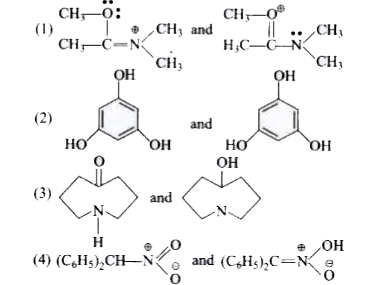Which of the following pairs of Lewis structure represent resonance contributor to the species?
H−C∣H=..N−N H−..C=+N∣H−Hand
H−C∣H=..N−H H−+C∣H−−N..−Hand
H−H∣C∣H=:O:∣∣C−H H−H∣C=:O:−H∣C−Hand
H3C−CH2−..O..−H H3C−..O..CH3and
The correct Answer is:B
To determine which pairs of Lewis structures represent resonance contributors to a species, we need to follow these steps:
1. Understand Resonance:
- Resonance structures are different ways of drawing the same molecule that only differ in the arrangement of electrons, not in the arrangement of atoms.
- The key point is that no atoms move; only the electrons (typically pi electrons or lone pairs) are delocalized.
2. Analyze Each Option:
- We will evaluate each pair of Lewis structures provided in the options to see if they can be considered resonance contributors.
3. Option A:
- Structures: HCH double bond NN and HC double bond NHH.
- Analysis: The number of atoms differs between the two structures (one has two nitrogens, the other has one nitrogen and a hydrogen). Therefore, these cannot be resonance structures.
4. Option B:
- Structures: A structure with a nitrogen atom bonded to carbon and a lone pair on nitrogen, and another structure where nitrogen has a negative charge and carbon has a positive charge.
- Analysis: The electrons can be delocalized between the nitrogen and carbon. This is a valid resonance structure since the atoms remain in the same position, and only the electrons are rearranged.
5. Option C:
- Structures: A carbon atom forming five bonds and another structure with a lone pair on oxygen.
- Analysis: The first structure is invalid as carbon cannot form five bonds. Thus, these cannot be resonance structures.
6. Option D:
- Structures: CH3CH2OH and CH3OCH3.
- Analysis: The entire CH3 group is moving from one structure to another, which violates the resonance rule (no atoms can move). Therefore, these are not resonance structures.
7. Conclusion:
- After analyzing all options, only Option B contains valid resonance structures.
Final Answer:
The correct answer is Option B.
- Resonance structures are different ways of drawing the same molecule that only differ in the arrangement of electrons, not in the arrangement of atoms.
- The key point is that no atoms move; only the electrons (typically pi electrons or lone pairs) are delocalized.
- We will evaluate each pair of Lewis structures provided in the options to see if they can be considered resonance contributors.
- Structures: HCH double bond NN and HC double bond NHH.
- Analysis: The number of atoms differs between the two structures (one has two nitrogens, the other has one nitrogen and a hydrogen). Therefore, these cannot be resonance structures.
- Structures: A structure with a nitrogen atom bonded to carbon and a lone pair on nitrogen, and another structure where nitrogen has a negative charge and carbon has a positive charge.
- Analysis: The electrons can be delocalized between the nitrogen and carbon. This is a valid resonance structure since the atoms remain in the same position, and only the electrons are rearranged.
- Structures: A carbon atom forming five bonds and another structure with a lone pair on oxygen.
- Analysis: The first structure is invalid as carbon cannot form five bonds. Thus, these cannot be resonance structures.
- Structures: CH3CH2OH and CH3OCH3.
- Analysis: The entire CH3 group is moving from one structure to another, which violates the resonance rule (no atoms can move). Therefore, these are not resonance structures.
- After analyzing all options, only Option B contains valid resonance structures.
The correct answer is Option B.
Similar Questions
Knowledge Check
Which of the following pairs does not represent the resonance contributors of the same species?
A B
B C
C D
D
Which of the following pairs does not represent resonance structures?
ACH3C≡⊕N−өOandCH3−⊕C=N−өOB CCH2=⊕N=өNandөCH2−⊕N≡ND
CCH2=⊕N=өNandөCH2−⊕N≡ND
Which of the following is pair of resonance structure?
A B
B C
C D
D
Which of the following pairs of structures represents conformation isomers?
View SolutionWhich of the following pairs of structures does not represent isomers?
View SolutionWhich of the following pairs of structures does not represent resonating structures?
View SolutionWhich of the following pairs of species are isostructural ?
View SolutionWhich of the following pairs of structures does not represent isomers?
View Solution

